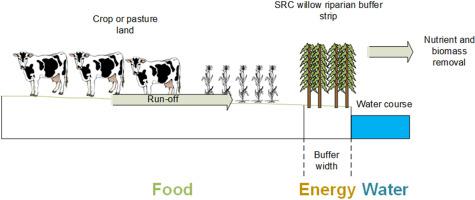Biomass & Bioenergy ( IF 5.8 ) Pub Date : 2020-12-06 , DOI: 10.1016/j.biombioe.2020.105903 David Livingstone , Beatrice M. Smyth , Aoife M. Foley , Simon T. Murray , Gary Lyons , Chris Johnston

|
The focus of this study is to show that by understanding the food-energy-water nexus, potential unforeseen negative outcomes can be avoided in the pursuit of sustainable development. To do this, this paper uses a novel approach to compare a combined farm and short rotation coppice willow system, in which the willow was planted as a riparian buffer, with a food-only and an energy only system. The impact of each system was investigated through the lens of the food-energy-water nexus using life cycle assessment techniques. Data from previous research was adapted in order to quantify the impacts for a typical Irish dairy farm, which is indicative of intensive agriculture across Europe. On a typical Irish dairy farm, the implementation of a short rotation coppice willow riparian buffer strip could reduce total nitrogen and phosphorus leachate by 14% and 9% respectively. Total CO2eq emissions could be reduced by 16.5% if energy from the willow displaces fossil fuels, while the impact on milk production and profit is minimal. Thus, the use of short rotation coppice willow as a riparian buffer strip has the potential to reduce strain on the entire food-energy-water nexus. By considering the food-energy-water nexus, the negative impacts of the food-only and energy-only systems were also highlighted.
The paper also shows how a better understanding of the food-energy-water nexus supports the United Nations Sustainable Development Goals and could help ameliorate the impact of climate change on the food-energy-water ecosystem.
中文翻译:

柳树在集约化农业中的应用,以减少对食物-能源-水之间关系的压力
这项研究的重点是表明,通过理解食物-能源-水的联系,在追求可持续发展方面可以避免潜在的无法预料的负面结果。为此,本文采用一种新颖的方法来比较农场和短期轮作的小灌木林柳树系统,其中柳树被种植为河岸缓冲带,仅具有食物和能量。使用生命周期评估技术,通过食物—能量—水关系的镜头研究了每个系统的影响。改编了先前研究的数据,以量化对典型的爱尔兰奶牛场的影响,这表明整个欧洲都在进行集约化农业。在典型的爱尔兰奶牛场,实施短轮伐木的柳树河岸缓冲带可分别减少总氮和磷浸出液14%和9%。总CO如果柳树产生的能量替代化石燃料,则2 eq排放量可减少16.5%,而对牛奶产量和利润的影响却很小。因此,使用短旋转的矮灌木柳作为河岸缓冲带有可能减少整个食物-能量-水联系的压力。通过考虑食物-能源-水的联系,还强调了仅食物和仅能源系统的负面影响。
该文件还表明,如何更好地理解粮食-能源-水的联系如何支持联合国可持续发展目标,并有助于减轻气候变化对粮食-能源-水的生态系统的影响。











































 京公网安备 11010802027423号
京公网安备 11010802027423号